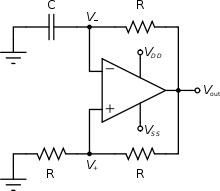The oscillator circuit is made up of two reactive elements inductor and capacitor. It is also known as tank circuit. In electronic circuit it produces a periodic, oscillating electronic signal often a sine wave or a square wave.

The two elements capacitor and inductor are capable to storing energy. The oscillators convert direct current (DC) to an alternating current (AC) from a power supply. The capacitor stores energy in its electric field, when there is a potential difference between its plates. The inductor or coils can stores energy in its magnetic field in the same way when a current flows through the coil.
The Q factors of oscillators are infinite because of the inductor and capacitor both treated as loss free. The oscillators are widely used in many electronics devices.
The process of charging and discharging of a condenser and from the motion of electron, between the two plates of the capacitor forms an oscillatory current.
The electric energy of the capacitor is converted into the magnetic energy of the coil and vice versa during this process. A device which is made of a condenser and a coil is able to sustain oscillations in it, called an oscillator.
